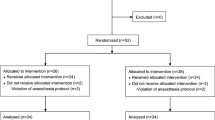Abstract
Purpose. The aim of this study was to investigate the reliability of end-tidal CO2 tension (PetCO2) as a predictor of PaCO2 during anesthesia in patients breathing spontaneously via a cuffed oropharyngeal airway (COPA).
Methods. Twenty adult patients scheduled for minor sur-gery were included in this study. After propofol injection, an appropriate size of COPA was inserted. Anesthesia was maintained with 60% nitrous oxide in oxygen (total flow rate of 5 l·min−1) supplemented with propofol infusion. The patients were allowed to breathe spontaneously throughout the procedure. PaCO2 and PetCO2 were simultaneously measured when a steady state of anesthesia was reached.
Results. PaCO2 (48.8 ± 5.4 mmHg, range 36.2–58.0 mmHg) was higher than PetCO2 (43.1 ± 4.2 mmHg, range 32–51 mmHg) in all patients. The difference between end-tidal and arterial CO2 tension was 5.7 ± 3.2 mmHg (range 0.5–13.0 mmHg), and was significantly correlated with PaCO2 (P < 0.01).
Conclusion. The results of this study suggest that PetCO2 in anesthetized patients breathing spontaneously through a COPA is sometimes unreliable as an indicator of PaCO2 level, and there is some possibility of unexpected hypercapnia.
Similar content being viewed by others
Author information
Authors and Affiliations
Additional information
Received for publication on August 31, 1998; accepted on February 9, 1999
About this article
Cite this article
Kobayashi, Y., Seki, S., Ichimiya, T. et al. Cuffed oropharyngeal airway and capnometry: comparison of end-tidal and arterial carbon dioxide pressures. J Anesth 13, 136–139 (1999). https://doi.org/10.1007/s005400050044
Issue Date:
DOI: https://doi.org/10.1007/s005400050044




